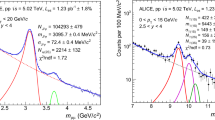Abstract
We investigate the production of bottomonium states in pp collisions by focusing on their production cross sections as functions of the rapidities and the transverse momenta at various collision energies. Based on the measurements of the \(\Upsilon \text {(1S)}\) production cross section at \(\sqrt{s}=2.76\), 5.02, and 7.0 TeV by the CMS Collaboration, we obtain the production cross section of the \(\Upsilon \text {(1S)}\) at \(\sqrt{s}=8.16\) TeV using both the extrapolation method and a fixed order with next-to-leading log (FONLL) analysis. We also use an extrapolation technique to discuss the \(\Upsilon \text {(2S)}\) and the \(\Upsilon \text {(3S)}\) production cross sections in pp collisions at \(\sqrt{s}=8.16\) TeV. We expect our evaluation of the \(\Upsilon \text {(1S)}\) production cross sections at \(\sqrt{s}=8.16\) TeV to be helpful in not only understanding those in pp collisions but also studying various effects such as CNM effects in PbPb collisions. Moreover, we hope the production cross sections of \(\Upsilon \text {(1S)}\), \(\Upsilon \text {(2S)}\), and \(\Upsilon \text {(3S)}\) estimated here will play important roles as useful references in measuring the nuclear modification factor, \(R_{AA}\), for \(\Upsilon \text {(1S)}\), \(\Upsilon \text {(2S)}\), and \(\Upsilon \text {(3S)}\), which will be available soon from a PbPb collision analysis at \(\sqrt{s}\) = 5.02 TeV.














Similar content being viewed by others
References
F. Karsch, E. Laermann, in Quark-Gluon Plasma III, R. C. Hwa and X.-N. Wang, eds. World Scientific Publishing Co. Pte. Ltd., 2004. arXiv:hep-lat/0305025
E.V. Shuryak, Sov. Phys. JETP 47, 212 (1978)
T. Matsui, H. Satz, Phys. Lett. B 178, 416 (1986)
A. Mocsy, P. Petreczky, Phys. Rev. Lett. 99, 211602 (2007). arXiv:0706.2183
C.M.S. Collaboration, EPJC 77, 252 (2017)
C.M.S. Collaboration, Phys. Lett. B 790, 270 (2010)
R.L. Thews, M. Schroedter, J. Rafelski, Phys. Rev. C 63, 211602 (2001). arXiv:hep-ph/0007323
A. Andronic, P. Braun-Munzinger, K. Redlich, J. Stachel, Nucl. Phys. A 789 (2007) 334–356. arXiv:nucl-th/0611023
R. Vogt, Phys. Rev. C 81, 044903 (2010)
C. Gerschel, J. Hufner, Phys. Rev. B 207, 253 (1988)
M. Laine, O. Philipsen, P. Romatschke, M. Tassler, JHEP 03, 054 (2007)
R. Sharma, I. Vitev, Phys. Rev. C 87, 044905 (2013)
F. Bossu, Z. C. del Valle, A. de Falco, M. Gagliardi, S. Grigoryan, G. Martinez Garcia, arXiv:1103.2394 [nucl-ex]
S. Cho, D.H. Moon, J. Korean Phys. Soc. 71, 134 (2017)
ALICE Collaboration, JHEP 1807, 160 (2018)
ALICE Collaboration, Eur. Phys. J. C. 77(6), 392 (2017)
ALICE, LHCb Collaborations, ALICE-PUBLIC-2013-002, LHCb-CONF-2013-013, http://cds.cern.ch/record/1639617
M. Cacciari, M. Greco, P. Nason, JHEP 9805, 007 (1998)
M. Cacciari, S. Frixione, P. Nason, JHEP 0103, 006 (2001)
M. Cacciari, P. Nason, R. Vogt, Phys. Rev. Lett. 95, 122001 (2005)
C.M.S. Collaboration, Phys. Lett. B 727, 101–125 (2013)
A.M. Sirunyan, CMS Collaboration et al., Phys. Lett. B 780, 251 (2018)
C. Patrignani, et al. (Particle Data Group), Chin. Phys. C 40, no. 10, 100001 (2016)
D.W. Sivers, S.J. Brodsky, R. Blankenbecler, Phys. Rept. 23, 1–121 (1976)
Acknowledgements
We thank the reviewer very much for helpful comments and suggestions on the paper. This research was supported by the Basic Science Research Program through the National Research Foundation of Korea (NRF) funded by the Ministry of Science, ICT and Future Planning (NRF-2021R1A2C2012584), by a 2017 Research Grant from Kangwon National University (No. 520170291), and by a National Research Foundation of Korea (NRF) grant funded by the Korea government (MSIT) (No. 2019R1A2C1087107).
Author information
Authors and Affiliations
Corresponding author
Additional information
Publisher's Note
Springer Nature remains neutral with regard to jurisdictional claims in published maps and institutional affiliations.
Rights and permissions
About this article
Cite this article
Moon, D.H., Cho, S. Production of bottomonium states in pp collisions at \(\sqrt{s} = 8.16\) TeV. J. Korean Phys. Soc. 79, 1007–1018 (2021). https://doi.org/10.1007/s40042-021-00319-4
Received:
Revised:
Accepted:
Published:
Issue Date:
DOI: https://doi.org/10.1007/s40042-021-00319-4




